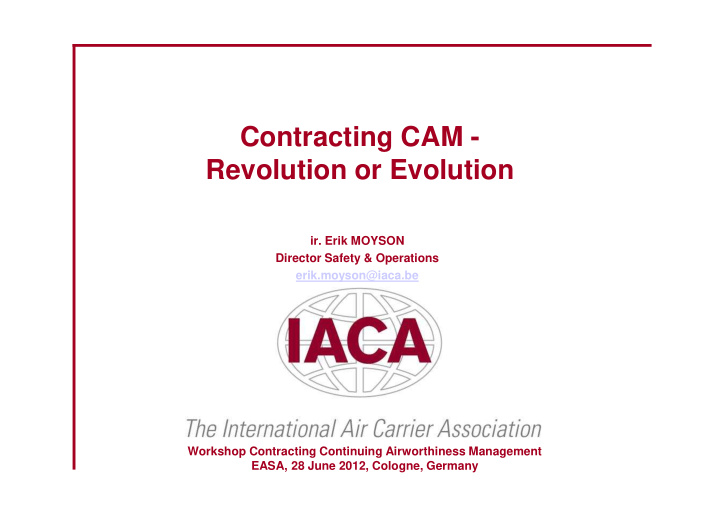



Contracting CAM - Revolution or Evolution ir. Erik MOYSON Director Safety & Operations erik.moyson@iaca.be Workshop Contracting Continuing Airworthiness Management EASA, 28 June 2012, Cologne, Germany
IACA member airlines
IACA member airlines � are CAT AOC holder • Commercial Air Transport • Air Operator Certificate • 32 airlines, 800+ aircraft � are CAMO approved (Part-M.G ) • may (sub)contract some CAM tasks • no CAM contracted to organisations not established as CAT technical organisations (i.e. no subcontract) • do contract CAM tasks to organisations that are established CAT technical organisations • CAMO of CAT AOC provides CAM services to subsidiary operators as well as external operators • decision / follow-up and general oversight remains responsibility of contracting operator
Reasons for contracting CAM � Real (dynamic) vs ideal (steady state) world • small operators • start-up operations • introduction new aircraft / engine type � Synergy (financial & quality) • subsidiary operators • group of operators with separate AOC but under the same ownership structure � Continuity • lease organisations to maintain expensive assets compliant with standards and regulations • lessee contracts CAM to CAMO of CAT AOC lessor
Extent of CAM contracts � Small operators and Start-up operations typically contract all CAM tasks � Medium size operators typically contract specific CAM tasks: • AD/SB evaluations • maintenance program development & upkeep • reliability control • engine condition monitoring � Large operators • share/pool CAM activities per aircraft / engine type • contract each other or affiliated engineering organisations
Advantages contracting - operator � Organisational • keep the organisation small • no need to invest in specialised / scarse knowledge � Financial • economy of scale • small operators can hardly afford specialised staff � Operational and technical quality • 24/7 available specialised staff • benefit using a/c and engine type experienced CAMO • larger sample allows for better statistics � Leasing • CAM contracted to lessor (continuity CAM) by lessee (no Part-M.G required)
Disadvantages subcontracting - operator � Quality and monitoring • extend quality system to unapproved organisation � Oversight • operators’ oversight limited to tasks subcontracted • ‘‘dedicated’’ staff, per audit to another CAT AOC � Organisational • required level of capability, contradicting reason for subcontracting � Complexity • subcontracting to non-approved organisation is more complex than contracting to approved organisation
Advantages contracting – contracted CAMO � Financial • economy of scale, similar to increasing own fleet • contracted CAMO can work more efficiently � Expertise • center of excellence • pooling of technical and reliability data makes for better statistics � No duplication • does not experience additional oversight when contracted by more CAT AOC operators
Disadvantages subcontracting – “camo” � Duplication • multiple audits by different contracting operators � Complexity • unapproved organisations have no established (approved) procedures of their own • but have to work under the procedures of the (different) contracting operators
Advantages contracting - authority � Oversight • organisations are subject to oversight related to their Part-M.G approval � Quality • center of excellence aircraft / engine type • better quality CAM tasks by contracted CAMO than by smaller operator • pooling of technical and reliability data makes for better statistics � Lease out • continuity CAM when contracted by lessee to lessor • aircraft stays in same controlled environment
Disadvantages subcontracting - authority � Number of subcontracted organisations • not limited, approve / accept each set-up � Authority control and Oversight • unapproved organisation not subject to oversight • oversight by subcontracting operator is less effective � Duplication • multiple audits per subcontracting operator � Responsibilities • operators (without proper resources) subcontract CAM to unapproved organisations (who are not accountable) � Complexity • subcontracting to unapproved organisation is more complex than contracting to approved
Shortcomings of subcontracting CAM � Operators • often subcontract all CAM tasks without extending quality system due to lack of technical expertise � Oversight of unapproved organisations • efficacy quality audits alone as oversight questionable • operators may rely on others for oversight � Contracting to Part-M.G • has not created safety issues, as CAMO is approved and has technical infrastructure and staff � Management Continuing Airworthiness must be robust • hence, should stay with approved organisations and • oversight by their competent authorities
Summary contracting CAM contracting contracted competent operator CAMO authority Quality and Oversight to unapproved monitoring Duplication Duplication organisations Oversight Complexity Responsibility Complexity Complexity Organisational Financial Expertise to approved Operational and Financial Quality organisations technical quality No duplication Continuity Leasing Start-up Synergy reason New type Expertise Group
IACA view 1. Commercial Air Transport 2. support contracting CAM , but NPA was too complex 3. CAM shall only be performed by approved organisations 4. disconnect Part-M.G CAMO from AOC 5. rewrite Part-M to change default position • where ‘‘CAMO is integral part of AOC’’ • to ‘‘minimum organisational requirements to manage contract with a CAMO’’ 6. flexibility • Option A : manage contract with CAMO • Option B : in-house CAMO • Option C : combination, per fleet (*) (*) considering continuity CAM for short-term leases
Contracting CAM: Revolution or Evolution � Revolution ? • fundamental change in a relatively short period ? • CAT AOC holders have been contracting all/some CAM tasks for some time � Evolution ? • gradual change over a longer period ? � Contracting CAM is not new • early 70s, introduction of wide boy aircraft • AF/AZ/IB/LH/SN pooled engineering & maintenance A300, A310, B747, DC10 (ATLAS) • KL/SK/SR/UT pooled DC10 (KSSU) � Evolution of regulatory environment • from national to harmonisation at EU level
Thank you for your attention
Recommend
More recommend